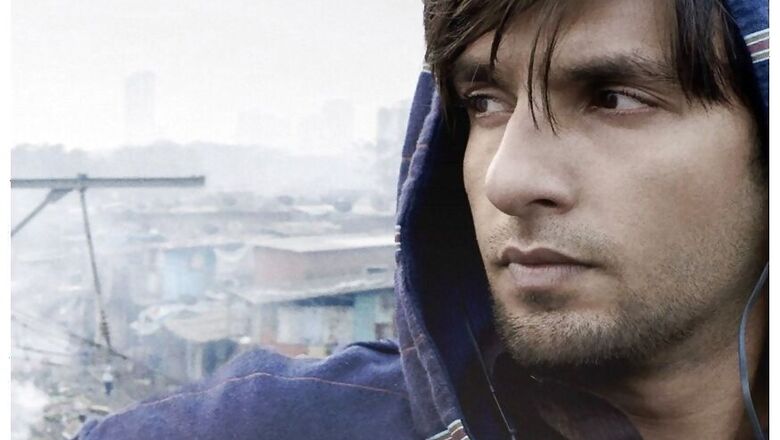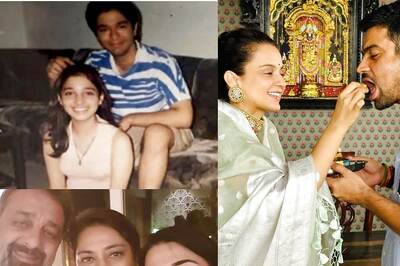
views
In 2008, after Danny Boyle's Slumdog Millionaire released, which was a rags-to-riches story of an orphan boy from the slums, debates stirred up on whether the film was poverty porn. Many believed that the filmmaker used the poverty in Mumbai slums as an exotic factor in an exploitative manner. While the debates were never settled, after 2008, there was a distinctive boom in slum tourism in Mumbai, thanks to many foreigners who came to see how people lived in slums.
At one point in Zoya Akhtar's film, Gully Boy, we witness one such guided tour of Dharavi, Asia's second-largest slum, located in Mumbai. A man ushers a group of foreign tourists into Murad's (Ranveer Singh's) kholi (house). The foreigners marvel at the cramped existence of the slum dwellers, their nifty use of space. A gobsmacked woman from the group clicks photos, and a man with a friendly smile strikes up a conversation with our hero, Murad.
Murad tells this man that he likes his T-shirt, in reply to which the man explains that the portrait on his T-shirt is of a famous American rapper, Nas. But before he can finish, Murad begins to recite the lyrics of Nas' famous song, NY State of Mind. Amazed that someone from a Mumbai slum knows Nas, this man asks Murad if he can take a photo of his, Murad doesn't reply but covers his face with his hand nonchalantly, the man clicks a photo anyway and leaves after saying, 'Thank you'.
In this short scene, Akhtar communicates a lot. Murad refusing to pose for the photo instantly tells you that he doesn't care about how he is perceived by outsiders, especially foreigners who see nothing but poverty in their slums. While abject poverty is a reality Murad puts up with, like every single slum dweller of India, Akhtar's film isn't about that.
It is about an artist's fight to rise above these apparent struggles for existence and finding his own calling. Dharavi, however, fills most of the frames of the film, as we see Murad slowly 'changing his reality to match his dreams'.
What makes Gully Boy such a wonderful film, despite having the most cliched story at its core - an underdog trying to prove his worth - is that the film not only has strong, quirky characters like Safeena (Alia Bhatt), and MC Sher (Siddhant Chaturvedi) but also shows a great deal of authenticity in its portrayal of places, people and situations.
Rarely has Mumbai, especially Dharavi, been portrayed with such complexities and nuance as Akhtar has achieved in this film. Gully Boy is the filmmaker's unabashed declaration of love for this city and its underbelly. While several Bollywood films are based in Mumbai, in Gully Boy we see a Mumbai that Bollywood seldom flaunts.
There are no bird view shots of skyscrapers or the Queen's necklace at Marine Drive. At no point do we see the crazy rush outside CST. The pigeons flying like confetti around the Gateway of India make no cameo either. But still, Gully Boy couldn't have been more Mumbaiya in its essence.
The sea link never features in the film, but the meeting place of Safeena and Murad is a small bridge on a sea of garbage, a quintessential Mumbai sight, no matter which part of the city you live in. There is one long shot at the beginning of the film where we see the slums and tall buildings together, cramped into one frame, divided by the railway tracks of Mumbai locals showing us the obvious economic disparity that marks the cityscape of Mumbai.
Mumbai is one of those cities with the highest level of economic disparity in India, and that difference is most obvious in Akhtar's film as Murad chauffeurs a rich girl whose family he works for. In this scene, Murad picks the girl up from a club where he had driven her. When she boards the car, Murad realises that she is very upset but as a driver, there is little he can do. As he drives her home, the girl silently cries in the back seat. He doesn't say another word to her, but in his head, he has already written a poem about the distance between them because of their class differences.
"Tumse hamdardi bhi nahi kar sakta main,
Mere bas ki baat nahi hai.
Main yeh behete anshu pochu,
Itni meri aukat nahi hai."
Another beautiful scene which speaks a great deal about the living situations in the slums surprisingly isn't shot in the slums at all. In this scene, we see Murad use the washroom of Sky's (Kalki Koechlin) posh house. After washing his hands, he stops to measure the length of the washroom with his feet. As he walks the entire length of the bathroom, it becomes heartbreakingly obvious that he is measuring up the loo against his own tiny apartment in Dharavi which is perhaps as big as the bathroom or only slightly bigger, and yet has to accommodate him along with his father, brother, mother, grandmother and a new addition to his family - his stepmother.
Akhtar's film beautifully depicts through her characters not only the physical spacial confinement of slum dwellers, but also the constraining effect that such overcrowded existence has on the emotional and psychological levels on these people. The only other film which, although greatly different in texture, comes remotely close to depicting Mumbai with all its different socio-economic layers is Kiran Rao's 2011 film, Dhobi Ghat.
What makes Gully Boy even more realistic and Mumbai centric are a bunch of rappers from the city who have cameos in the film. From Dopedaddy to Tony Sebastian, to MC Altaf and Dee MC, many real rappers feature in the film. Of course, Divine too makes an appearance. The film is said to be loosely based on the lives of Divine and Naezy. As these rappers keep the sound as authentic Gully rap, it is Vijay Maurya who breathes the spirit of Mumbai into Gully Boy with his dialogues peppered with colloquial, everyday terms like dhopna, altarpanthi, bahar gaon, and hateli. Jay Oza's cinematography makes Gully Boy an immersive experience. His lens gives an insider view into the common yet often ignored sights of Mumbai - be it the lanes of Dharavi, railway platforms, inside of BEST buses or upscale buildings.
While the film's climax is about winning a rap battle which will allow the winner to open a concert for Nas, we never see Nas perform in the film. But as Murad raps Nas' NY State of Mind to the amazement of a foreigner early on in the film, you realise, that it isn't surprising at all for Murad's character to love and know Nas' work. NY State of Mind is Nas' tribute to the streets of New York, an insider look into the lives lived in a ghetto. Who will understand that feeling better than Murad, who lives a life in similar constraints of another ghetto, in the gullies of another metropolis?
In two hours thirty minutes, Akhtar plays with many themes and subplots in her film - an artist's quest for his identity, a father-son estrangement, and a love story. But above all these themes, Akhtar constantly breaks our stereotypes about Dharavi and slum dwellers by choosing not to tell us yet another story of poverty or gang wars, but instead picking a story about a young man's creative ambitions and passions.

















Comments
0 comment